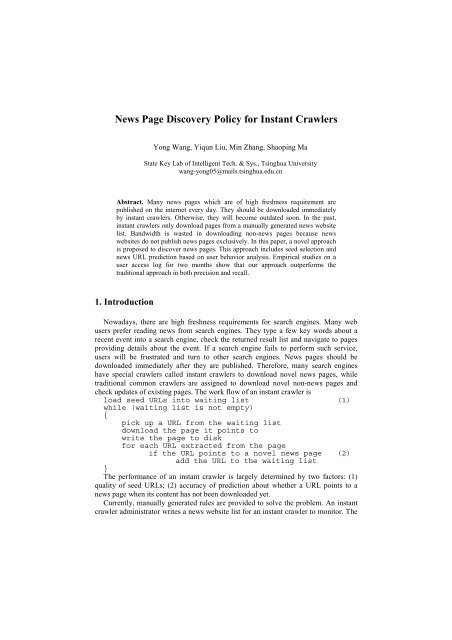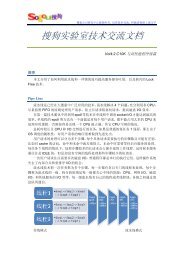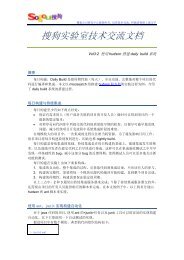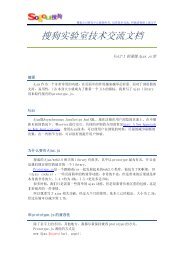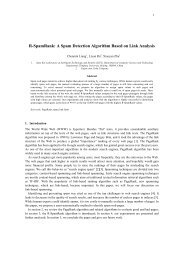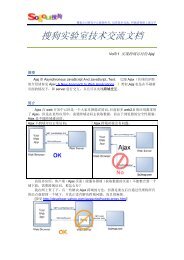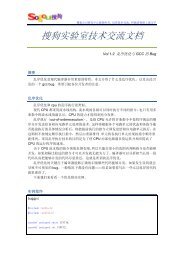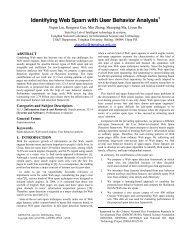News Page Discovery Policy for Instant Crawlers
News Page Discovery Policy for Instant Crawlers
News Page Discovery Policy for Instant Crawlers
Create successful ePaper yourself
Turn your PDF publications into a flip-book with our unique Google optimized e-Paper software.
<strong>News</strong> <strong>Page</strong> <strong>Discovery</strong> <strong>Policy</strong> <strong>for</strong> <strong>Instant</strong> <strong>Crawlers</strong><br />
Yong Wang, Yiqun Liu, Min Zhang, Shaoping Ma<br />
State Key Lab of Intelligent Tech. & Sys., Tsinghua University<br />
wang-yong05@mails.tsinghua.edu.cn<br />
Abstract. Many news pages which are of high freshness requirement are<br />
published on the internet every day. They should be downloaded immediately<br />
by instant crawlers. Otherwise, they will become outdated soon. In the past,<br />
instant crawlers only download pages from a manually generated news website<br />
list. Bandwidth is wasted in downloading non-news pages because news<br />
websites do not publish news pages exclusively. In this paper, a novel approach<br />
is proposed to discover news pages. This approach includes seed selection and<br />
news URL prediction based on user behavior analysis. Empirical studies on a<br />
user access log <strong>for</strong> two months show that our approach outper<strong>for</strong>ms the<br />
traditional approach in both precision and recall.<br />
1. Introduction<br />
Nowadays, there are high freshness requirements <strong>for</strong> search engines. Many web<br />
users prefer reading news from search engines. They type a few key words about a<br />
recent event into a search engine, check the returned result list and navigate to pages<br />
providing details about the event. If a search engine fails to per<strong>for</strong>m such service,<br />
users will be frustrated and turn to other search engines. <strong>News</strong> pages should be<br />
downloaded immediately after they are published. There<strong>for</strong>e, many search engines<br />
have special crawlers called instant crawlers to download novel news pages, while<br />
traditional common crawlers are assigned to download novel non-news pages and<br />
check updates of existing pages. The work flow of an instant crawler is<br />
load seed URLs into waiting list (1)<br />
while (waiting list is not empty)<br />
{<br />
pick up a URL from the waiting list<br />
download the page it points to<br />
write the page to disk<br />
<strong>for</strong> each URL extracted from the page<br />
if the URL points to a novel news page (2)<br />
add the URL to the waiting list<br />
}<br />
The per<strong>for</strong>mance of an instant crawler is largely determined by two factors: (1)<br />
quality of seed URLs; (2) accuracy of prediction about whether a URL points to a<br />
news page when its content has not been downloaded yet.<br />
Currently, manually generated rules are provided to solve the problem. An instant<br />
crawler administrator writes a news website list <strong>for</strong> an instant crawler to monitor. The
2 Yong Wang, Yiqun Liu, Min Zhang, Shaoping Ma<br />
instant crawler starts from the homepages of these websites as seed URLs. A newly<br />
discovered URL will be added to its waiting list if it is in the monitored web sites.<br />
This policy works fine, but there are still some problems. First, news websites<br />
which are not so famous are likely to be omitted from seed list, even though they<br />
contain high quality news pages. Second, some web sites are associated with<br />
particular events. For example, doha2006.sohu.com reported the 15th Asian Games. It<br />
provided news service only during the 15th Asian Games session. The crawler<br />
administrator may not be so sensitive to the emergence and disappearance of<br />
temporary news websites. Third, there are many web sites which contain both news<br />
pages and non-news pages. For example, auto.sohu.com is a website about<br />
automobiles. There are news pages reporting car price fluctuation and also non-news<br />
pages providing car maintenance in<strong>for</strong>mation. Only news pages in this website should<br />
be downloaded by instant crawlers. A web site is too large a granularity to make this<br />
discrimination. These problems can be solved with our method.<br />
<strong>News</strong> pages provide in<strong>for</strong>mation on recent events. Users are interested in a news<br />
page only in a short period after it is published. As more and more users get to know<br />
the event, fewer users are likely to read that page. Non-news pages are not relevant to<br />
recent events. Users are always interested in these pages and access them constantly.<br />
This feature is used to identify news pages. If a page accumulates a large proportion<br />
of click throughs in a short period after publication, it is probable to be a news page.<br />
A policy <strong>for</strong> instant crawlers to discover news pages is proposed based on user<br />
behavior analysis in click through data. In the beginning, news pages are identified<br />
based on how their daily click through data evolves. Then web pages which directly<br />
link to many news pages are used as seed URLs, so instant crawlers can start with<br />
these seed URLs and download many news pages after only one hop. Web<br />
administrators usually publish news pages under only a few paths, such as<br />
www.website1.com/news/, www.website2.com/2007news/. So URLs of many news<br />
pages in the same location share the same news URL prefixes. If there are already<br />
many news pages sharing the same news URL prefix, it is likely that novel news<br />
pages will be stored under that path and their URLs will start with that prefix. An<br />
instant crawler can add a newly discovered URL to its waiting list if it starts with any<br />
one of the news URL prefixes.<br />
The rest of this paper is organized as follows: Section 2 introduces earlier research<br />
in priority arrangement <strong>for</strong> waiting list of crawlers; Section 3 describes the dataset<br />
which will be used later; Section 4 discusses and verifies a few properties of news<br />
pages; Section 5 addresses the problems in seed selection and news URL estimation;<br />
the approach proposed is applied in the dataset and the result is analyzed in Section 6;<br />
Section 7 is the conclusion of this paper.<br />
2. Related Work<br />
Earlier researchers per<strong>for</strong>med intensive studies on evolutionary properties of the<br />
web, including the rate of updates of existing pages and that of novel page<br />
appearance[1][2]. The conclusion is that the web is growing explosively[3] and it is<br />
almost impossible to download all novel pages. Web crawlers face a frontier which is
<strong>News</strong> <strong>Page</strong> <strong>Discovery</strong> <strong>Policy</strong> <strong>for</strong> <strong>Instant</strong> <strong>Crawlers</strong> 3<br />
consisted of discovered by not downloaded URLs. Priority arrangement in the frontier<br />
is important. This problem is studied from several perspectives. Some researchers<br />
tried to find a balance between downloading novel pages and refreshing existing<br />
pages[4][5]. They studied page update intervals and checked existing pages only<br />
when necessary. <strong>Crawlers</strong> downloaded novel pages during the intervals. Focused<br />
crawlers only download pages related to a given topic[6][7][8][9]. They estimate<br />
whether a URL is worth downloading mainly based on its anchor text. Other<br />
crawlers[10][11][12][13] predict quality of novel URLs and download candidates of<br />
high quality. This work is similar with ours. We also make an order of the frontier, in<br />
the perspective of freshness requirements instead of page quality. <strong>Page</strong>s of high<br />
freshness requirement are downloaded with high priority, while others can be<br />
downloaded later.<br />
3. Data Set<br />
Anonymous click through data <strong>for</strong> consecutive 60 days from November 13 th 2006<br />
to January 11 th , 2007 is collected by a proxy server. Each record is a structure below:<br />
Request Date and Time Client IP Requested URL Referrer URL<br />
Navigation history is also recorded. A user accesses the Requested URL from a<br />
hyperlink in the Referrer URL. Referrer URL is null if a user types the address<br />
instead of clicking a hyperlink. Daily click through data <strong>for</strong> all 75,112,357 pages is<br />
calculated. Multiple requests to a single page from the same IP in one day are counted<br />
as one click through to avoid automatically generated requests by spammers. <strong>Page</strong>s<br />
whose average daily click throughs are less than one are filtered out <strong>for</strong> lack of<br />
reliability, leaving daily click through history of 975,151 pages <strong>for</strong> later studies.<br />
4. <strong>News</strong> <strong>Page</strong> Properties<br />
Click through data evolution of news pages is different from that of non-news<br />
pages. Many news pages are linked by a relatively small number of hub pages. <strong>News</strong><br />
pages stored together share the same URL prefixes. These properties can be used in<br />
discovering novel news pages.<br />
focus.cn is a web site about real estate which publishes both news pages and nonnews<br />
ones. 3,040 pages from focus.cn are annotated manually, of which 2,337 are<br />
labeled news and 703 are labeled non-news. The proposed news page properties are<br />
verified with this dataset.<br />
4.1 Click Through Evolution of <strong>News</strong> <strong>Page</strong>s<br />
A news page reports recent events. It is attractive only in a short period after it is<br />
published. Later, as more and more users are familiar with the event, the page<br />
becomes outdated and fewer users are glad to access it. Its daily click through number<br />
decreases greatly. In contrast, a non-news page is not related with a recent event and
Number of Click Throughs<br />
4 Yong Wang, Yiqun Liu, Min Zhang, Shaoping Ma<br />
does not become obsolescent. Its daily click through number does not fluctuate<br />
greatly over time. Click through evolutions of the two types of web pages are shown<br />
in Fig. 1.<br />
a news page<br />
a non-news page<br />
0 a a+m n<br />
Time<br />
Fig. 1. Click through evolution of a typical<br />
news page and a typical non-news page<br />
Click throughs of a news page concentrate in the first few days after its birth, while<br />
those of a non-news page are more evenly distributed. ClickThroughConcentration,<br />
which measures the extent of click through concentration, is defined below:<br />
ClickThroughConcentration�p� �<br />
Proportion<br />
∑<br />
���<br />
��� ���������������� ∑<br />
�<br />
� ��� ����������������<br />
�⁄ �����<br />
where ClickThroughp(i) is the number of click throughs of page p on the ith day, a<br />
is the first day when ClickThroughp(a) is non-zero, m is the parameter, n is the width<br />
of the observation window, n - a is the length of the observed life of page p,<br />
���<br />
�<br />
∑��� ClickThrough��i�� ∑��� ClickThrough��i� is the number of click throughs<br />
accumulated in the first m days divided by that accumulated in the observed window.<br />
The birthday a of the news page is shown in Fig. 1. The numerator reflects the<br />
proportion of click throughs received in the first m days. The denominator is used <strong>for</strong><br />
normalization. If daily click throughs of a page are evenly distributed,<br />
ClickThroughConcentration would be 1. Otherwise, if click throughs concentrate in<br />
the first m days, ClickThroughConcentration would be greater than 1.<br />
ClickThroughConcentration of all 3,040 pages from focus.cn are calculated to<br />
verify the previous assumption and their distribution is shown in Figure 2.<br />
ClickThroughConcentration of 91.9% non-news pages is less than 3 and the average<br />
is 1.86. The average ClickThroughConcentration of news pages is 9.11.<br />
ClickThroughConcentration of news pages is more widely distributed because pages<br />
reporting breaking news get through users rapidly and become outdated soon, while<br />
those which are not so attractive need more time to get through users and their daily<br />
click throughs are not so concentrated.<br />
As is shown in Figure 2, ClickThroughConcentration of news pages is larger than<br />
that of non-news pages. This is a useful feature to discriminate news pages from nonnews<br />
ones.<br />
0.2<br />
0.15<br />
0.1<br />
0.05<br />
0<br />
news pages<br />
non-news pages<br />
0 5 10 15<br />
Click Through Distribution<br />
Fig. 2.<br />
ClickThroughConcentration<br />
distribution<br />
(1)
4.2 <strong>News</strong> <strong>Page</strong>s are Linked by <strong>News</strong> Hub <strong>Page</strong>s<br />
<strong>News</strong> <strong>Page</strong> <strong>Discovery</strong> <strong>Policy</strong> <strong>for</strong> <strong>Instant</strong> <strong>Crawlers</strong> 5<br />
A news hub page is a web page which has links pointing to many news pages. It is<br />
valuable in discovering news pages. Web page link structure is not available in our<br />
data set because page content is not stored. But link structure can be reconstructed<br />
from navigation history. <strong>Page</strong> A links to <strong>Page</strong> B if a user accessed <strong>Page</strong> B from<br />
referrer <strong>Page</strong> A. It is true that links which have not been clicked are omitted. But from<br />
users’ perspective, since they are not clicked at all, there is not much difference<br />
whether they exist.<br />
home.focus.cn/, house.focus.cn/ and house.focus.cn/excl/msnhot.php are three<br />
major news hub pages. They have links pointing to 1,953 different news pages. A<br />
large proportion of news pages can be discovered from these news hub pages.<br />
4.3 Many <strong>News</strong> <strong>Page</strong>s’ URLs Start with the Same Prefixes<br />
Many news pages cluster in the same news folders. A folder in a website is a news<br />
folder if the proportion of news pages in it is large enough.<br />
/news/, /msgview/ and /msn/ are the news folders where most news pages from<br />
focus.cn are stored. Their distribution is shown in Table 1. As is shown, three news<br />
folders contain 99% news pages and only 4 non news ones.<br />
Table 1. Web page distribution in news folders and other folders<br />
<strong>News</strong> <strong>Page</strong>s Non-<strong>News</strong> <strong>Page</strong>s<br />
In the three news folders 2,322 4<br />
In the other folders 15 699<br />
Additionally, a dynamically generated page, such as website.com/a.asp?p=1, is<br />
likely to be a news page if most other pages generated from the same program<br />
website.com/a.asp with different parameter values are news pages.<br />
A news URL prefix is a string with which many news pages’ URLs start. <strong>Page</strong>s in<br />
the same folder or generated from the same program share the same URL prefixes.<br />
<strong>Instant</strong> crawlers can reach many news pages with a small overhead of non-news ones<br />
if they only download novel pages whose URL start with news URL prefixes.<br />
These news page properties discussed above are common in many websites. They<br />
can be used to increases the discoverability of novel news pages <strong>for</strong> instant crawlers.<br />
5. <strong>News</strong> <strong>Page</strong> <strong>Discovery</strong> <strong>Policy</strong> <strong>for</strong> <strong>Instant</strong> <strong>Crawlers</strong><br />
<strong>News</strong> hub pages are used as seed URLs to discover novel news pages if they link<br />
to many previous news pages. Novel news pages are usually stored in the same<br />
location with known news pages. So news pages are identified to find where novel<br />
news pages are likely to be stored. A newly discovered URL will be downloaded if its<br />
URL starts with one of the news URL prefixes.
6 Yong Wang, Yiqun Liu, Min Zhang, Shaoping Ma<br />
5.1 Generate Seed URL List <strong>for</strong> an <strong>Instant</strong> Crawler<br />
It is proved in Section 4.1 that ClickThroughConcentration of most news pages is<br />
larger than that of most non-news ones. For each web page in the click through log, it<br />
is a news page if its ClickThroughConcentration is less than a threshold. Otherwise, it<br />
is a non-news page. <strong>News</strong> pages can be automatically identified with this method.<br />
A seed URL <strong>for</strong> an instant crawler is of high quality if a large number of news<br />
pages can be discovered from it in only one or two hops. It is probable that novel<br />
news pages will be linked by pages which already have links to many known news<br />
pages. <strong>News</strong> hub pages which have linked most news pages are included in seed list.<br />
5.2 Estimate Whether a URL Points to a <strong>News</strong> <strong>Page</strong><br />
Some news pages cluster in the same folder and some are dynamically generated<br />
from the same program with different parameter values. URL prefixes can be found<br />
from known news pages. Given a website, a URL prefix tree is built according to its<br />
folder structure. In this tree, a node stands <strong>for</strong> a folder. Node A has a child node B if<br />
B is the direct subfolder of A. Web pages are leaf nodes. A dynamic program is also a<br />
non-leaf node. Dynamic pages generated from that program are its leaf nodes. Each<br />
non-leaf nodes are labeled by two numbers: the number of news pages and that of<br />
non-news ones directly and indirectly under that node. For example, a website.com<br />
contains four pages: /index.html, /folder/page.htm, /news.jsp?p=1 and /news.jsp?p=2.<br />
Its URL prefix tree is organized as in Fig. 3.<br />
website.com/ (2/4)<br />
folder/ (0/1) index.htm (non-news) news.jsp (2/2)<br />
page.htm (non-news)<br />
Fig. 3. A URL prefix tree of a sample website<br />
?p=1 (news) ?p=2 (news)<br />
Each non-leaf node is scored with the proportion of the number of news pages to<br />
that of all pages under that node. All prefix trees are traversed from the roots. A node<br />
is a news node if its score is greater than a threshold, then the traverse stops.<br />
Otherwise, its children are tested. This algorithm is described below.<br />
Find<strong>News</strong>Node(TreeNode N){<br />
if (score of N is greater than the threshold){<br />
N is a news node;<br />
return;<br />
}<br />
<strong>for</strong>each child in NonLeafChildrenOfN<br />
Find<strong>News</strong>Node(child);<br />
}
<strong>News</strong> <strong>Page</strong> <strong>Discovery</strong> <strong>Policy</strong> <strong>for</strong> <strong>Instant</strong> <strong>Crawlers</strong> 7<br />
A news URL prefix consists of all nodes on the path from the root to the news<br />
node. Take the tree in Fig. 3 <strong>for</strong> example, if the node “news.jsp” is a news node,<br />
“website.com/news.jsp” is a news URL prefix. It is probable that URLs starting with<br />
news URL prefixes point to news pages and is worth downloading.<br />
6. Experiment and Evaluation<br />
An experiment is conducted in the dataset described in Section 3. All pages<br />
appeared in the dataset are classified as news pages and non-news ones. A seed URL<br />
list is made and news URL prefixes are generated. An instant crawler can start from<br />
the seed URLs and decides whether a newly discovered URL is worth downloading<br />
based on whether the URL starts with one of the news URL prefixes.<br />
6.1 Experiment<br />
ClickThroughConcentration of all pages are calculated. A page is classified as a<br />
news page if its ClickThroughConcentration is greater than a threshold p. <strong>Page</strong>s from<br />
focus.cn which have been annotated manually are used as training set in which there<br />
are 2,337 news pages and 703 non-news pages. The best per<strong>for</strong>mance is achieved<br />
when p=1.91 and the maximized hit (the number of pages correctly classified) is<br />
2,682, miss (the number of news pages that are classified as non-news) is 188 and<br />
false alarm (the number of news pages that are classified as non-news) is 177. This<br />
threshold is applied on all pages and 147,927 are labeled news pages and the other<br />
827,224 are labeled non-news.<br />
A navigation record from page A to page B indicates that B is linked by A. The<br />
number of news pages linked by each page is calculated and the top 1,542 pages<br />
which link to the most news pages are included in the seed URL list. The number of<br />
seed URLs is the same with that in the baseline used later <strong>for</strong> comparison.<br />
In URL prefix trees, a node is a news node if the proportion of news pages under<br />
that node is larger than a threshold, where 0.8 is used. 439 nodes are labeled news<br />
nodes. Larger threshold can be used if the bandwidth is limited and that wasted in<br />
downloading non-news pages is unaf<strong>for</strong>dable. If an instant crawler has enough<br />
bandwidth and wants more news pages, the threshold can be smaller.<br />
6.2 Evaluation<br />
Sogou Inc. is a search engine company in China. Its instant crawler uses a manually<br />
generated website list which contains 1,542 news websites. Homepages of these<br />
websites are seed URLs and the instant crawler downloads pages from these websites<br />
only. This policy is used as the baseline to be compared with ours.<br />
46,210 different news pages are linked by 1,542 homepages of news sites in<br />
Sogou’s list, while 79,292 different news pages are linked by 1,542 news hub pages<br />
which are included in our seed list. Not all homepages are the best seed URLs. There<br />
are websites which publish both news pages and non-news ones. The index pages of
8 Yong Wang, Yiqun Liu, Min Zhang, Shaoping Ma<br />
news channels are better candidates <strong>for</strong> seed URLs. For example, finance.sina.com.cn<br />
is a financial website. The web log shows that most of its news pages are linked by<br />
finance.sina.com.cn/stock/, not its homepage. So finance.sina.com.cn/stock/ instead of<br />
the homepage should be included in the seed list.<br />
The instant crawler of Sogou Inc. downloads all pages from their site list, while our<br />
instant crawler downloads pages whose URLs start with one of the news URL<br />
prefixes. The result is shown is Table 2.<br />
Table 2 Per<strong>for</strong>mance comparison<br />
Baseline Our Method<br />
Number of Downloaded <strong>News</strong> <strong>Page</strong>s 86,714 101,870<br />
Number of Total Downloaded <strong>Page</strong>s 177,801 111,934<br />
Precision 48.8% 91.0%<br />
Recall 58.6% 68.9%<br />
There are 147,927 news pages in the dataset. Precision is the proportion of<br />
downloaded news pages in all downloaded pages. Recall is the proportion of<br />
downloaded news pages in all news pages in the data set. As is shown in Table 2,<br />
86,714 news pages are in the site list, while 101,870 are covered by the URL prefixes.<br />
<strong>Instant</strong> crawlers can downloads more news pages with less burden of non-news ones.<br />
7. Conclusion<br />
In this paper, an effective news page discovery policy is proposed. The current<br />
instant crawlers which are assigned to download news pages cannot produce<br />
satisfactory result due to news page distribution complexity. In this paper, we propose<br />
and verify a few features of news pages. Then these features are used in seed URL<br />
selection and news URL prediction. The per<strong>for</strong>mance of instant crawlers is improved<br />
both in precision and recall because they can discover more news pages with less<br />
bandwidth wasted in downloading non-news pages.<br />
References<br />
1. D. Fetterly, M. Manasse, M. Najork, and J. L.Wiener. A large-scale study of the evolution<br />
of web pages. Software Practice and Experience, 2004.<br />
2. B. E. Brewington and G. Cybenko. How dynamic is the web? WWW9 / Computer<br />
Networks, 2000.<br />
3. Brewington, B. & Cybenko, G. (2000). How Dynamic is the Web, Proceedings of<br />
WWW9 –9th International World Wide Web Conference (IW3C2), pp. 264-296.<br />
4. J Cho, H Garcia-Molina. Effective page refresh policies <strong>for</strong> Web crawlers. ACM<br />
Transactions on Database Systems (TODS), 2003<br />
5. SHKAPENYUK, V. AND SUEL, T. 2002. Design and implementation of a highper<strong>for</strong>mance<br />
distributed web crawler. In Proceedings of the 18th International Conference<br />
on Data Engineering (San Jose,Calif.).<br />
6. Menczer F,Belew R.Adaptive Retrieval Agents:Internalizing Local Context and Scaling<br />
up to the Web[J].Machine Learning,2000,39 (23):203-242.
<strong>News</strong> <strong>Page</strong> <strong>Discovery</strong> <strong>Policy</strong> <strong>for</strong> <strong>Instant</strong> <strong>Crawlers</strong> 9<br />
7. Pant G,Menczer F.Topical Crawling <strong>for</strong> Business Intelligence[C]//Proc 7th European<br />
Conference on Research and Advanced Technology <strong>for</strong> Digital Libraries<br />
(ECDL).Trondheim,Norway,August 17-22,2003.<br />
8. K. Stamatakis, V. Karkaletsis, G. Paliouras, J. Horlock, et al., Domain-specific Web site<br />
identification: the CROSSMARC focused Web crawler, in: Proceedings of the 2nd<br />
International Workshop on Web Document Analysis (WDA2003), Edinburgh, UK, 2003.<br />
9. Filippo Menczer , Gautam Pant , Padmini Srinivasan, Topical web crawlers: Evaluating<br />
adaptive algorithms, ACM Transactions on Internet Technology (TOIT), v.4 n.4, p.378-<br />
419, November 2004<br />
10. J. Cho, H. Garcia-Molina, and L. <strong>Page</strong>. Effecient crawling through URL ordering.<br />
WWW8 / Computer Networks, 30(1-7):161–172, 1998.<br />
11. N. Eiron, K. S. McCurley, and J. A. Tomlin. Ranking the web frontier. In Proc. 13th<br />
WWW, pages 309–318, 2004.<br />
12. Nadav Eiron and Kevin S. McCurley. Locality, hierarchy, and bidirectionality in the web.<br />
In Workshop on Algorithmsand Models <strong>for</strong> the Web Graph, Budapest, May 2003.<br />
13. Serge Abiteboul, Mihai Preda, and Grgory Cobena. Adaptive on-line page importance<br />
computation. In Proc. 12th World Wide Web Conference, pages 280–290, 2003.<br />
14.


